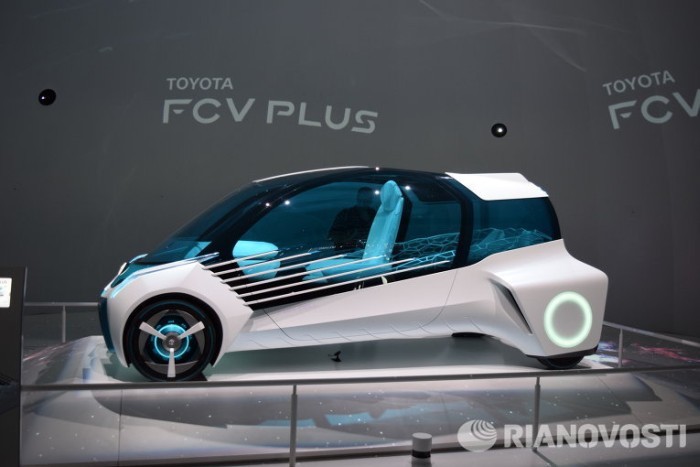Honda's hydrogen car can power a whole house for 7 days

While the whole world admires new models of electric cars, the Japanese Honda does not forget about another type of alternative fuel: hydrogen. Honda has been making hydrogen cars since the late 80s, so the release of a new modern model should not be surprising.
Hydrogen is obtained, for example, by electrolysis of water using solar cells. Despite the obvious disadvantages, hydrogen cars still have a number of advantages over conventional lithium-ion batteries. The most important thing is the extra fuel.
At the Tokyo Motor Show, Honda introduced the five-seater FCV Clarity sedan. A flat lithium-ion battery is installed in the car under the front seats, where the electricity from the combustion of hydrogen flows, then the battery is powered by an electric motor. Power reserve - 700 kilometers.
')
Honda FCV Clarity - a significant step forward in the evolution of hydrogen vehicles. Honda reduced the cost of the hydrogen fuel cell, and the cell size has decreased by a third, so now it is about the size of a conventional V6 engine. So much compact size allowed to squeeze it under the hood - this design is used for the first time for all vehicles on fuel cells. Previously, they had to be placed in the trunk and almost in the cabin, but under the hood they could not fit.
Now the fuel cell is not inferior to the V6 engine in size, weight and other characteristics. It works fine and at low temperatures. The hydrogen tanks themselves in the FCV Clarity are under the rear seats and behind them.
The fuel cell provides an output of 100 kW, and the electric motor has a maximum power of 130 kW.
To solve the problem of hydrogen filling stations, Honda launched the Smart Hydrogen Station compact electrolysis station to extract hydrogen from water at home. True, the company did not show it to the public at the auto show, did not name the price and the date of commencement of sales. But if hydrogen production at home becomes available, it can significantly increase the popularity of hydrogen vehicles.
Honda FCV Clarity has another cool feature: if you connect it to the Power Exporter 9000 transformer (in the photo), then hydrogen can be used to power household appliances and even the entire home power supply. Hydrogen from one fuel cell is enough to supply an average Japanese house with electricity for seven days!

This is the perfect gadget for country travel. Right in the forest, you can safely connect a computer, put a refrigerator.
Honda will start leasing cars for municipalities and legal entities in March 2016. Later, the export of cars to Europe and the USA will begin, but one can hardly count on mass sales at a retail price of 7.66 million yen ($ 62,807).

The previous Honda model, the hydrogen-powered FCX Clarity, was not particularly popular: only 72 units were sold worldwide. But the recently released Toyota Mirai diverges much more actively, its sales in the USA started a week ago.
By the way, Toyota showed concept cards FCV Plus at the Tokyo Motor Show, which also runs on hydrogen and is also able to “share” unused electricity.

Source: https://habr.com/ru/post/368829/
All Articles